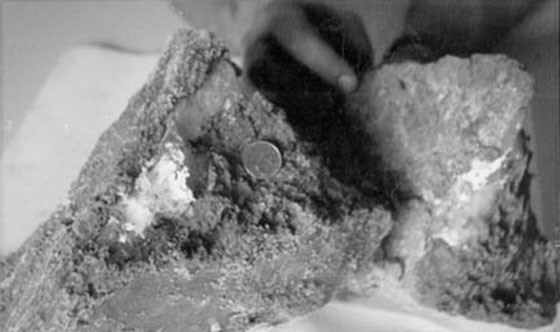Extremely Rare Frozen Silver Found at Keno
While mining by hand near Keno City on July 30, two Yukon geologists working for Archer, Cathro and Associates stumbled upon some frozen silver.
By Whitehorse Star on August 15, 1990
Whitehorse Star, Wednesday, August 15, 1990
Extremely Rare Frozen Silver Found at Keno
While mining by hand near Keno City on July 30, two Yukon geologists working for Archer, Cathro and Associates stumbled upon some frozen silver.
The silver was lying in an ice seam of permafrost, and Al Archer says that only one other specimen of this type has ever been found in the world.
In a much-celebrated discovery, Dr. Bob Boyle of the Geological Survey of Canada encountered the phenomenon in the 1950s at the United Keno Hill Ltd. mine.
"This is the first time I've seen it since Boyle found it in the 1950's” Archer said in an interview Tuesday. "As far as I know, this is the only place in the world where it occurs.”
Naturally-occurring frozen silver is exceptionally rare because a geochemical reaction has to take place at temperatures below freezing level, explained Archer, something that would take a great deal of time.
"If you or I went to a chemist and said, ‘Can silver move (chemically) in ice and form crystals?', he'd say ‘No.'
"Of course, it happened over hundreds of thousands of years.”
Although no one knows for sure, Archer estimates the specimens of frozen silver pre-date the last glacial age and could be more than a million years old. The ice is very, very old, he said.
Preserving frozen samples presents its own problems. The geologists took 10 samples from the site, eight of which melted in the mad dash to the camp freezer.
Two specimens weighing 20 kilograms in total survived, however, and were wrapped in plastic and transported to Whitehorse for further examination.
The specimens are now on their way to the Canadian Museum of Nature in Ontario. Archer said it wasn't easy finding a museum with a mineral division possessing the right sort of freezer for the specimens.
"You can't have a freezer which desiccates or evaporates.” It must have some mechanism to control the frosting-up which happens in all freezers over time.
To find a suitable museum, Archer enlisted the help of Joe Nagel, of the geology department at the University of British Columbia. Robert Waller, the conservator of the Mineral Sciences Section for the Canadian Museum of Nature, phoned him a few days later.
Waller told Archer "that he would be thrilled to obtain such unique specimens.”
Dry ice was flown into Whitehorse Tuesday night specifically for shipping purposes to keep the specimens frozen on their journey to the museum. They were wrapped in the dry ice and packed into a picnic cooler overnight. They left this morning for Ottawa via Vancouver.
Archer has arranged for the cargo supervisor in Vancouver to personally meet the Whitehorse plane and transport the specimens to the Ottawa-bound aircraft. The cargo supervisor in Ottawa will also meet the plane and hand-deliver the specimens into Waller's care.

Be the first to comment